I cook for a lot of reasons. Among my motivations are career, hunger, family, friends, and curiosity. When Mike Hargis (winner of the banh mi selfie contest) shared his grandma’s recipe for a southern Vietnamese classic dish of pork and eggs simmered with coconut juice, I was intrigued. Mike posted the recipe on the Viet World Kitchen Facebook page and I noticed that his maternal grandma (Ba Ngoai in Vietnamese) totally didn’t make thit heo kho trung in the traditional sense.
If you have Into the Vietnamese Kitchen, the recipe on page 146 is a simple, classic approach – chunks of pork leg with fat, skin and lean, coconut water/juice, caramel sauce, fish sauce, a little sugar and boiled eggs. Some cooks like to add a touch of onion and garlic too. My family likes to taste the porkiness. Regardless of seasoning, thit heo kho trung is southern Viet comfort food that’s simmered stovetop and eaten with rice; the eggs get cut or broken up with some of the soupy cooking liquid to create a rich sauce to flavor the rice. It's a dish that southern Vietnamese people enjoy year around but also during Tet (Lunar New Year).
Mike’s grandma used pork shoulder, soy sauce, coconut water, onion, fresh and powdered garlic, and lots of black pepper along with the requisite eggs. The dish is cooked in the oven. Say what? How’d did a woman of her generation have access to an oven? How does the dish taste with the soy sauce?
I made his grandma’s recipe cutting it roughly in half since my household is comprise of just two adults. I used less soy sauce and employed a hefty amount of garlic instead of fresh and powdered. (I don’t have powdered garlic in my pantry.) Instead of using a roasting pan, I opted for giant claypot as an old-fashioned nod; you could make it in a Dutch oven.
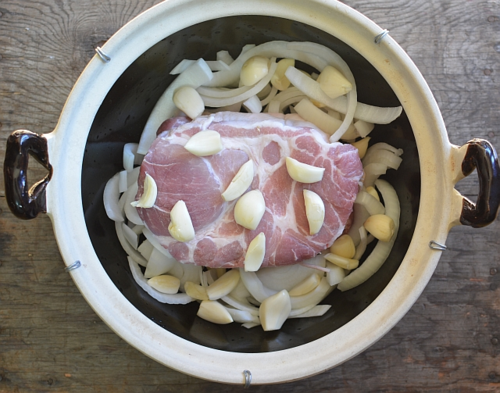
For the coconut juice, I used canned coconut water which is much closer to the refreshing liquid from a young (green) coconut. I baked the claypot as prescribed and the house was filled with good food aromas. The result was very good. Viet people don't typically cook giant hunks of meat so I understand the preference for the oven -- you can cook an entire roast in there with ease.
Because it’s a salty, rich dish, a little pickle side was in order. The citrusy red cabbage pickle from the Banh Mi Handbook worked splendidly to balance out the flavors, textures, and colors. To further balance the meal, I add boiled green beans one night, broccoli on another.
I’ve been eating the pork and eggs all week long; kho dishes improve with age and this made a lot. My inquiring mind wanted to know a few things from Mike. I asked and he responded, sending a few family photos too.
Why did you decide to make the pork and egg dish? Your recipe called for five pounds of pork and two dozen eggs. How did your family eat all that up when your grandma made it?
We decided on thịt heo kho vối nước dừa và trứng [Mike likes to include all the diacritics] just because we haven't had it in a while. All that we modified was that we used coconut juice rather than water and oven over stove top. [Ah-so, the oven was Mike’s tweak. Coconut juice was more on point than water.] Other than that, all recipes originated from Bà Ngoại and Mom <3
When Bà ngoại made it, it only lasted maybe 2 days because all the relatives packed it for work LOL...ours lasted 5 days and that's what we ate for 5 days because we don't know when we'll get the mood to do it again:)
What kind of woman was your grandma? Her use of soy sauce instead of fish sauce, non-use of caramel sauce, and preference for water instead of coconut juice signaled that perhaps she wasn’t a woman of southern Vietnamese extraction. Plus, the dish was on the salty side instead of the sweet side. Was she from the northern region of Vietnam where foods are relatively salty and there is sometimes a blurring of Vietnamese and Chinese foodways? You can simmer foods with soy sauce instead of caramel sauce and fish sauce but the former is considered more Chinese.
Bà Ngoại is definitely from the north, even brought her temper when they migrated to Saigon and gracious enough to pass that temper from generation to generation. LOL. Bà Ngoại eventually came to Guam to live with us.
How did your family impact your interest in food? As it turns out, Mike’sgrandma passed away in 2002, then his mom in 2008, an uncle followed, then his father in 2010. Mike also added:
I have lots of fond memories of all of them and lots of pics that I would love to share with you...I will look for some very nice ones. When Mom and Bà Ngoại made it [the pork and egg dish], they used the stovetop...remember that my Father was in the U.S. Army so even back then, we had the American luxuries. [Many Viet cooks prepared meals atop a charcoal-fueled brazier back then.] My brother Tony was blessed to learn lots of cooking skills from Mom.
My Father sent Mom and us 4 kids out of Vietnam about a month before the fall of Saigon. He stayed behind to help sponsor more relatives and friends out...he ended up with part of the 'refugee' group in the end. We were pure Vietnamese kids in Guam...America.
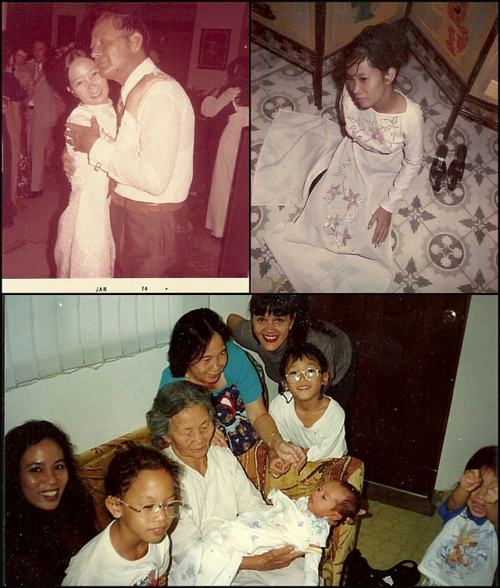 The Hargis family: Mike's parents in 1974. His mom in a classic pose. Four generations of Hargises having a darn good time.
The Hargis family: Mike's parents in 1974. His mom in a classic pose. Four generations of Hargises having a darn good time.My brother and I got into so many fights in school because all the kids were calling us 'refugee, refugee, refugee'. We had no idea what it meant but just sounded like teasing 🙂 ...Now we correct everybody's English, and sometimes even the local language here in Guam which is Chamorro. I even sing their language better than them LOL
Our Bà Ngoại has always been our inspiration, practically our Nanny from when we were born. We cried and cried and cried when we had to leave her behind in Saigon. And sorry, but I will never call it Ho Chi Minh City...
Bà Ngoại from my recollection, was an awesome cook. We had xôi [sticky rice] daily for breakfast, cơm chiên với thịt ruốc [fried rice with cotton pork (a dried, preserved pork, aka pork floss)] for lunch...and dinner was Mama's job, and she was an awesome cook as well 🙂
Perhaps it was Mike’s longing for his family that led to his making this pork and egg dish. In his tweaks, he added some southern Viet flair (the coconut juice) and injected a new layer of modernity (oven cooking). His calibration of his grandma's ecipe fascinated me. It’s what we all do every time we start to cook something, even if it’s a cherished family recipe.
So when I went to make the Hargis family recipe, I made my own tweaks. Aside from the fresh garlic, I used Kikkoman soy sauce because it has a darker hue than my regular Chinese-style soy sauce. I tried to imagine what Mike's grandma and mom would have used in Guam. To hedge the flavor, I employed about 25% less than the Hargises did.
Mike's novel oven cooking turned the dish into a Vietnamese pot roast, of sorts. Usually the pork is cut into chunks and then simmered. The Hargises cook a large piece then cut it later, which works with a shoulder roast because it retains a tender bite, a characteristic of this dish. Vietnamese people usually don't care for fork-tender meat.
This dish evoked Vietnamese kho but also Chinese red-cooked pork and Japanese char siu (the sliced pork served with ramen and in steamed buns). I thought I’d miss the fish sauce but I didn’t. The Hargis family rendition is a different version of a Viet classic. It has its own merits because it speaks to their bicultural experience.
Given Mike and his brother’s interest in food and cooking, this dish will likely be passed down through the generations. It will keep evolving as that’s the fiesty dynamic of Vietnamese cooking. I could see it in a slow cooker. For a gluten-free version, use soy sauce made without wheat.
If you have a family recipe and story to share, email me!
RECIPE
Pork and Eggs Simmered in Coconut Juice
Thịt Heo Kho Trứng
Yields: 8 servings
Ingredients
- 3 pounds boneless pork shoulder/butt roast
- 1 large yellow onion, thickly sliced
- Cloves from 2 medium heads of garlic
- 1 ¼ to 1 ½ cups Japanese-style soy sauce, such as Kikkoman
- ⅓ cup sugar
- 1 tablespoon black pepper, freshly ground preferred
- 2 cups canned or boxed unsweetened coconut water or the liquid inside 1 large young (green) coconut
- 1 dozen medium or large eggs
Instructions:
- Preheat the oven to 350F (180 or 175C). Put the pork into a claypot, Dutch oven or similar kind of pot. There should be about 1 inch (2.5 cm) clearance all around. Add the onion and garlic. In a separate bowl, stir together the soy sauce, sugar, and black pepper. Taste and adjust as needed for pleasant, slight intense flavor. Pour into the pot. Add the coconut juice and if needed, extra water to come to about ½ inch (1.25 cm) of the top of the pork. Cover and bake for 3 hours. Turn the pork over midway.
- Meanwhile, boil the eggs. (For guidance, see this post.) Once cool, peel the eggs and set aside.
- When the pork is done, remove it from the pot. Partially cover and let cool until you can handle it. Skim the fat from the top.
- Cut the pork into thick pieces, a scant ¾ inch thick and the size of a large domino. Return the pork and eggs to the pot. Bring to a simmer on the stove, then cook for 10 minutes before serving.
- Enjoy with rice. Mash up your eggs with some of the cooking liquid prior to adding to your rice with some of the pork. Bon appétit 🙂
Adapted from a recipe by Mike Hargis and family.













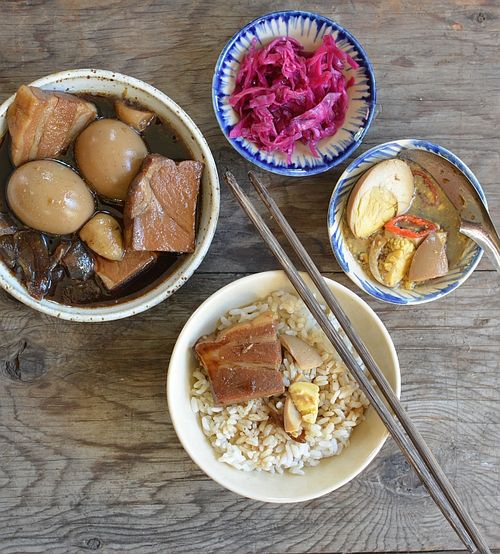
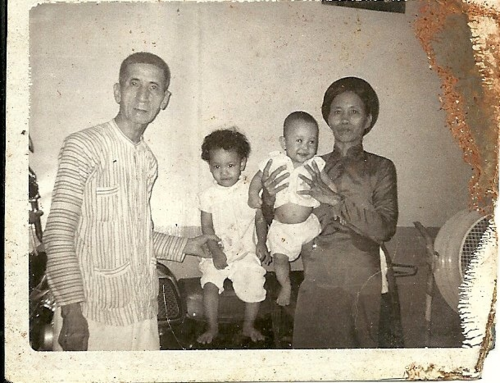
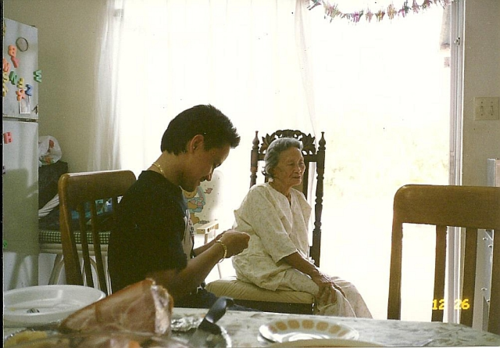




Thien says
I call it Saigon also!!